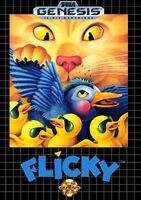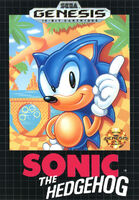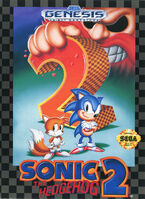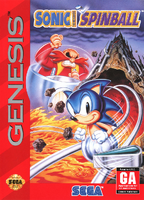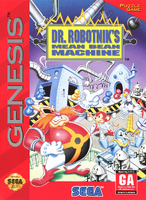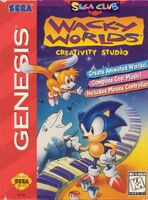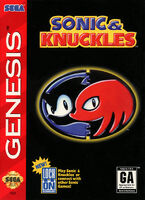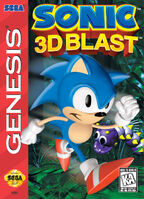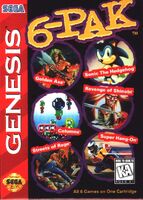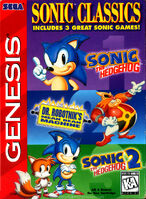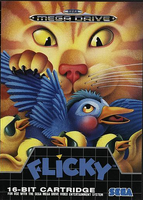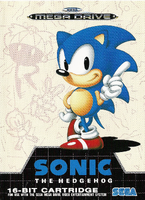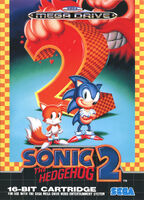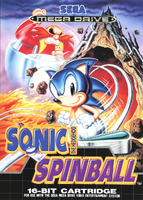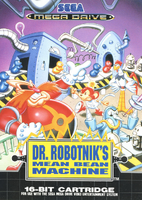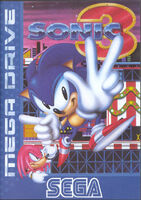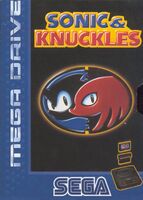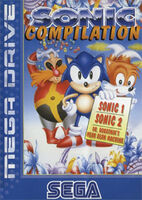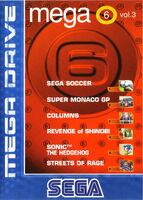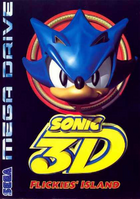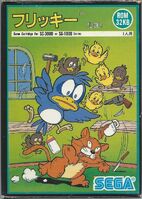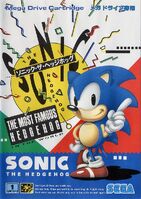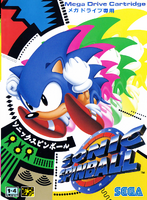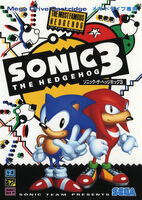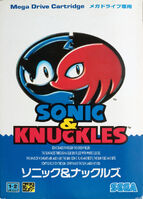Information in this article is about real-life people, companies, and objects, which do not relate to the in-universe Sonic series. |
- For the object in the Archie Comics, see Mega Drive (Archie).
The Sega Mega Drive (メガドライブ Mega Doraibu?), also known as the Sega Genesis in North America, is a 16-bit video game console released by Sega in 1988 in Japan and 1989 in the United States. It was the company's third home console, succeeding the Master System and a direct competitor of NEC's PC Engine/TurboGrafx-16 (which was released one year earlier and had a better success in Japan) and Nintendo's Super Famicom/Super Nintendo Entertainment System (which was released two years later and was also a fierce rival in the U.S.). The console has a well-known legacy with certain games available and is the system where the highly successful Sonic the Hedgehog franchise has debuted on. The Mega Drive/Genesis is by far Sega's most successful console before the company's transition from the hardware market to 3rd-party in the early 2000s following the commercial failure of the Dreamcast. The console was later succeeded by the Sega Saturn in 1994.
There are 11 Sonic games released for this system that have been ported to later games released by Sega, except Ristar, such as Sonic Mega Collection and Sonic Mega Collection Plus.
Sonic games[]
- Flicky
- Sonic the Hedgehog
- Sonic Eraser
- Sonic the Hedgehog 2
- Sonic Spinball
- Dr. Robotnik's Mean Bean Machine
- Sonic the Hedgehog 3
- Wacky Worlds Creativity Studio
- Sonic & Knuckles
- Sonic Compilation
- Mega 6 Volume 3
- Sonic 3D Blast
- 6-Pak
- Sonic Crackers (unreleased)
Characters introduced[]
- Sonic the Hedgehog
- Miles "Tails" Prower
- Badniks
- Dr. Eggman
- Knuckles the Echidna
- Mecha Sonic
- Mecha Sonic Mark II
Box artwork gallery[]
North America[]
| Gallery |
|---|
Europe[]
| Gallery |
|---|
Japan[]
| Gallery |
|---|
History[]
Although the Sega Master System was relatively successful in Europe, and later also in Brazil, it failed to ignite much attention in the North American or Japanese markets, which, by the mid-to-late 1980s, were both dominated by Nintendo's large market shares thanks to the Nintendo Entertainment System/Famicom, and ultimately lost to its rival in the 8-bit era.[8][9][10] Because of this, Sega seeked out a new way to make itself a much stronger competitor then before.
The first name Sega considered for its console was the MK-1601, but it ultimately decided to call it the "Sega Mega Drive". The name was said to represent superiority and speed, with the new and powerful Motorola 68000 processor in mind.[11] Sega intended to use the name "Mega Drive" worldwide, but the North American version instead went by the name "Genesis" due to a trademark dispute.[12]
Launch[]
The Mega Drive was released in Japan on October 29 1988,[13] almost exactly a year after the release of NEC PC Engine and the same year as the release of TurboGrafx-16 in North America. The Japanese release of the Mega Drive was a commercial failure in this region due to it already being overshadowed by the then-newly released Super Mario Bros. 3 on the Famicom in the same year, and remained a distant third behind the PC Engine and especially Nintendo's Super Famicom.
In 1987, Sega announced that the North American release date for the system (under the name "Sega Genesis") would be January 9 1989.[14] Sega initially attempted to partner with now-defunct Atari Corporation for distribution of the console in the U.S., but the two could not agree to terms and Sega decided to do it themselves.[15] Sega was not able to meet the initial release date and United States sales began on August 14 in test regions New York City and Los Angeles, with the North American release following by the end of the month.[4] Initially, although it proved to be technologically superior over the NES, the Genesis was not successful until the arrival of the original Sonic the Hedgehog in 1991, which immediately resulted in an intense rivalry between Sega and Nintendo by the release of the more advanced Super NES in the same year, infamously known as the "Console Wars", due to North America's previous dominant experience with the Nintendo Entertainment System and Sega's aggressive marketing in the region (which Nintendo also did the same). Throughout the 16-bit era, despite both companies' consoles were extremely popular in the U.S., neither could maintain a definitive lead, but the Super NES ultimately surpassed the Genesis in market sales by a small margin.
The European release was in September 1990, keeping its original name.[5] Following on from the European success of the Sega Master System, the Mega Drive became a very popular console in Europe like its predecessor and even outselling the Super NES. Unlike in other regions where the Famicom/Nintendo Entertainment System had been the dominant platform, the Master System was the most popular console in Europe at the time, which continued for the Mega Drive.
The Mega Drive's launch titles in Japan are Space Harrier II and Super Thunder Blade. In North America and Europe, more games were added including Altered Beast, Golden Axe, and Alex Kidd in the Enchanted Castle.
Marketing[]
The advertising of the Mega Drive's United States release as the Genesis was notorious for Sega's aggressive marketing specifically to challenge its established rival, Nintendo, head-on by all means possible and provide a more arcade-like experience than the NES at the time, creating the infamous "Genesis does what Nintendon't" (called "Sega does what Nintendon't" in Japan/Europe) slogan. In spite of this, Sega struggled to overcome Nintendo's sales, but eventually, by the time Sonic the Hedgehog was released and became successful, Sega brought up new slogans such as "Blast Processing" or "Welcome to the Next Level" to advertise the Mega Drive CPU's faster processing speed in platform games (7.67MHz compared to the Super NES' 3.58MHz) and position it as the "cooler" console aiming for older audiences. This continues with the Sega CD/32X add-ons.
In the United Kingdom, the most well-known of Sega's advertising slogans was "To be this good takes AGES, to be this good takes SEGA". Some of these adverts employed a rather inappropriate sentences for example, "The more you play with it, the harder it gets" displayed with an illustration of the waggling of a joystick.[16]
Another prominent figure in the European marketing was the "Sega Pirate", a talking one-eyed skull that starred in many TV adverts with a generally edgy and humorous attitude. Since the Mega Drive was already two years old at the release in Europe, the many games available at launch were naturally more in numbers compared to the launches in other regions. The ports of arcade titles like Altered Beast, Golden Axe and Ghouls 'n Ghosts, available in stores at launch, provided a strong image of the console's power to deliver an arcade-like experience.[17]
The arrival of Sonic the Hedgehog in 1991 was highly successful in Europe and especially North America, with the new Sega mascot becoming popular throughout the two continents and directly competing with Nintendo's Mario.[17]
In Brazil, the Mega Drive was released by Tectoy in 1990, only a year after the Brazilian release of the Sega Master System. Tectoy also ran the Internet service "Sega Meganet" in Brazil, as well as producing games exclusively for the Brazilian market.[18]
End of support and third-party licensing[]
The Mega Drive/Genesis was supported until 1997 worldwide, when Sega announced it was dropping support for it.[19] It was discontinued along with its predecessor, the Master System, to allow Sega to concentrate on its newer console, the Saturn. The Mega Drive's add-ons, the Mega CD and 32X, were also both discontinued at this point, having been the same general failures they were in the other regions.[20]
In 1997, Sega licensed the Mega Drive to Majesco so that it could re-release the console in the United States.[21] Majesco began re-selling millions of formerly unsold cartridges at a budget price together with the second model of the Genesis, until it later released a third version of it.
Backwards-compatibility[]
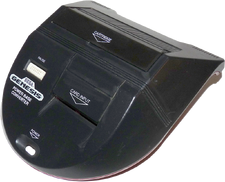
Sega Power Base Converter
One of the key design features of the console is its backwards compatibility with Sega's previous console, the Sega Master System. The 16-bit design is based upon the 8-bit design, albeit enhanced and extended in many areas. In order to achieve backwards compatibility, the Master System's central processor and sound chip (the Zilog Z80[22] and SN76489 respectively) are included in the Mega Drive, and the Mega Drive's Video Display Processor (VDP) is capable of the Master System's VDP's mode 4, though it cannot run in modes 0, 1, 2, or 3.
As the cartridge slot is of a different shape, Sega released the Power Base Converter, a separate device that sits between a Master System cartridge and the Mega Drive's cartridge slot. The Power Base Converter does not contain any Master System's hardware components, instead functioning as a pass-through device. The converter contains a top slot for cartridge-based games along with a front slot for card-based games, as well as the 3D glasses adapter. When a Master System game is inserted, the system puts the Z80 in control, leaving the Mega Drive's main 68000 processor idle.[22] This peripheral was released in Japan on 26 January 1989 for ¥4500[23] and can only be attached to the original model, making it incompatible with the later second and third revisions of the Mega Drive.[23]
Although the peripheral can play any game within the Master System's library, one particular game does not work with this device, which is F-16 Fighting Falcon.[24]
Versions[]
The Sega Mega Drive went through many different design changes and titles over the years it was in production. This list only includes standard Mega Drive variations and does not feature any "bundle" consoles such as the Sega CDX or TeraDrive.
| Title | Also known as | Year | Region | Distributor |
|---|---|---|---|---|
| Sega Mega Drive | Model 1 |
1988 | International | Sega
Samsung (KOR) |
| Mega Drive II | Model 2 |
1993 | ||
| Mega Drive III | N/A | Brazil | Tectoy | |
| Mega Game II[25] | 1997 | Portugal | Ecofilmes | |
| Genesis 3 | Model 3 | 1998 | United States | Majesco |
| Super Mega Drive 3[6] | N/A | 2001 | Brazil | Tectoy |
Add-ons[]
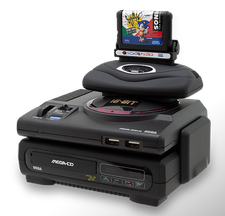
Mega Drive with the Sega CD and 32X add-ons as well as Sonic the Hedgehog locked on a Sonic & Knuckles cartridge (Japanese version).
The Sega Mega Drive features two optional add-ons: the Sega CD and Sega 32X. Both of these peripherals helped to expand the Mega Drive's lifespan into the next-generation of consoles (32-bit era).
- The Sega CD plays a high-quality CD-ROM using a slow 1x Optical Disc Drive while increasing audio and visual capabilities over the stock Mega Drive. This add-on was first launched in Japan on December 12 1991,[26] with a North American launch on October 15 of the following year.[27] The Sega CD is best known for the exclusive debut of Sonic the Hedgehog CD.
- The Sega 32X works as an "enhancement" over a stock Mega Drive console, with an additional 32-bit processor to process more complex graphical tasks. The 32X was released in North America on November 12 1994,[28] just a day before the Sega Saturn was launched in Japan. This peripheral is best known for being the exclusive platform of Knuckles' Chaotix. However, it was unsuccessful.
Sega Mega Jet[]
The Sega Mega Jet was another handheld version of the Sega Mega Drive. It was rented for use aboard Japan Airlines flights for both first and business class.[29]
The device lacked its own screen but could play Mega Drive cartridges when connected to a small armrest monitor used on Japan Airlines. The cord that connected to the display also supplied the device's power. An extra port was featured on the top of the Mega Jet so that a standard Mega Drive controller could be connected, and two players can play at once.
Four games for the flight were available, including Super Monaco GP and Sonic the Hedgehog. However, since the unit accepted standard Mega Drive cartridges, passengers could bring in and use their own. The Mega Jet was marketed in Japan as a portable Mega Drive and was available in limited quantities in department stores.
The Mega Jet eventually became the basis for the Sega Nomad, a portable Mega Drive with a backlit screen, that was released exclusively in the United States in 1995.
Sega Nomad[]
The Sega Nomad, also called Sega Genesis Nomad or just the Nomad, was a handheld game system sold for the North American consumer market which played Sega Mega Drive game cartridges. The system was similar to the Japanese Sega Mega Jet but featured a built-in color screen; the Mega Jet needed a separate monitor. Its codename during development was Project Venus, as per Sega's policy at the time of codenaming their systems after planets.
Game library[]
The Nomad does not have its own game library, but instead plays standard Genesis games. At the time of the Nomad's launch, the Genesis already had over 500 games available to play. However, no pack-in title was included for the Nomad. The Nomad can boot unlicensed, homebrew, and bootleg games made for the Genesis.
Some earlier third-party titles have compatibility issues when played on the Nomad but can be successfully played through the use of a Game Genie. Likewise, due to its lack of compatibility with any of the Genesis' add-ons, it is unable to play any games for the Sega Master System, Sega CD, or Sega 32X. The Nomad employs two different regional lockout methods, physical and software, but methods have been found to bypass these restrictions.
Trivia[]
- Japanese Mega Drive cartridges have a different shape and will not fit in either the American Genesis or the PAL region Mega Drive cartridge slot. Japanese Mega Drive systems also have a piece of plastic that slides in a place of the cartridge when the power switch is turned on, inserting a Genesis cart will make it impossible to turn on a Japanese console. Minor modifications to the plastic locks in the consoles will bypass the regional locks.
- However, the console's main board was designed with language and frequency jumper sets, which originally activated features in the same ROM for the different regions, this feature was later used to enable software-based regional locks that display warning messages that prevent the game from being played. Switches placed instead of the jumpers will bypass the locks.
- In region-locked games, if there is a multiple language feature, it can be changed with the switches after the game has booted-up.
- There are over 900 games released for the Mega Drive/Genesis across seven major regions: Japan, North America, Europe, Australasia, Korea, Asia, and Latin America.
- In Lego Dimensions, after Sonic follows Dr. Eggman through a portal and subsequently battles Robo Sonic, Mecha Sonic and Metal Sonic. After he is finished fighting, Metal Sonic explodes and hits the portal device causing three portals to open and the first model of the Sega Mega Drive flies out one of them.
- JAMMA made an arcade board called the "Sega Mega Play" in 1991, which has the ability to play Sega Mega Drive games. The hardware was released in Asia and the PAL regions, but never made it to North America.
- This was the first console with online connectivity via the Mega Modem add-on released in Japan only.
References[]
- ↑ 1.0 1.1 Mega Drive 2 (Japanese). Sega. Retrieved on 25 February 2022.
- ↑ Sega Mega Drive/Genesis Console Information. Console Database. Base Media. Retrieved on 4 June 2018.
- ↑ Gallery (Japanese). Sega. Retrieved on 25 February 2022.
- ↑ 4.0 4.1 Kent, Steven L. (2001). The Ultimate History of Video Games. Roseville, California: Prima Publishing. pp. 404–405. ISBN 0-7615-3643-4.
- ↑ 5.0 5.1 "Console Zone: Sega MegaDrive". New Computer Express (97): 48. 15 September 1990. Archived from the original.
- ↑ 6.0 6.1 Tecblogger (17 September 2010). Tectoy History (Portuguese). Tectoy. Archived from the original on 23 March 2012. Retrieved on 26 February 2022.
- ↑ "Letter". Sega Force Mega: 19. November 1993. Archived from the original. Retrieved on 25 February 2022.
- ↑ Kent, Steven L. (2001). The Ultimate History of Video Games: The Story Behind the Craze that Touched our Lives and Changed the World. Roseville, California: Prima Publishing. pp. 303, 360. ISBN 0-7615-3643-4.
- ↑ Bolitz, Christoph . Sega Mega Drive information. skillreactor. Retrieved on 2008-04-01.
- ↑ Szczepaniak, John (September 2006). Retroinspection: Sega Mega Drive. Retro Gamer. Retrieved on 29 March 2018.
- ↑ Console Database Staff . Sega Mega Drive/Genesis Console Information. http://www.consoledatabase.com. Console Database/Dale Hansen. Retrieved on 18 October 2007.
- ↑ Sheff, David (1993). Game Over: How Nintendo Zapped an American Industry, Captured Your Dollars, and Enslaved Your Children. New York: Random House. pp. 352. ISBN 0-679-40469-4.
- ↑ Kent, Steven L. (2001). The Ultimate History of Video Games: The Story Behind the Craze that Touched our Lives and Changed the World. Roseville, California: Prima Publishing. pp. 401. ISBN 0-7615-3643-4.
- ↑ SEGA'S BIZARRE EARLY 1990S VIZ ADVERTS. UK Resistance (2006). Retrieved on 20 October 2007.
- ↑ 17.0 17.1 McFerran, Damien (2007). Hardware Focus - Sega Megadrive / Genesis. VC Reviews. Retrieved on 19 October 2007.
- ↑ Tiago, Tex Pine (26 February 2008). How Piracy can Break an Industry - the Brazilian Case. Retrieved on 14 April 2008.
- ↑ Console Database Staff . Sega Mega Drive/Genesis Console Information. http://www.consoledatabase.com. Retrieved on 18 October 2007.
- ↑ Blake, Snow (30 July 2007). The 10 Worst-Selling Consoles of All Time. GamePro. Retrieved on 20 May 2008.
- ↑ Sega (Majesco) Genesis 3. pelikonepeijoonit. Retrieved on 6 March 2006.
- ↑ 22.0 22.1 Sega Mega Drive information.
- ↑ 23.0 23.1 Mega Drive Adaptor (Japanese). Sega. Archived from the original on 15 February 2013. Retrieved on 25 February 2022.
- ↑ Master System Converter Instruction Manual, p. 7.
- ↑ Coelho, Miguel (26 February 2015). Coleccionismo de Mega Drive (Portugese). PUSHSTART. Archived from the original on 30 September 2021. Retrieved on 26 February 2022.
- ↑ Mega-CD (Japanese). Sega. Archived from the original on 16 July 2014. Retrieved on 29 March 2014.
- ↑ Beuscher, David . Sega CD: Biography. AllGame. Archived from the original on 14 November 2014.
- ↑ Kent, Steven L. (2001). "The "Next" Generation (Part 1)". The Ultimate History of Video Games: The Story Behind the Craze that Touched our Lives and Changed the World. Prima Publishing. ISBN 0-7615-3643-4.
- ↑ 29.0 29.1 29.2 29.3 Mega Jet (Japanese). Sega. Archived from the original on 9 January 2013. Retrieved on 25 February 2022.
- ↑ 30.0 30.1 Ultimate Gamer (4): 14. November 1995.
- ↑ gabox (11 January 2018). Sega Nomad - Videogame History #30 - Retro Review. Steemit. Retrieved on 11 June 2018.
- ↑ Wesley, David; Barczak, Gloria (23 May 2016). Innovation and Marketing in the Video Game Industry: Avoiding the Performance Trap. CRC Press. pp. 84, 85. ISBN 1317116496, 9781317116493.
External links[]
- Sega Mega Drive at Wikipedia, the free encyclopedia
- Sega Nomad at Wikipedia, the free encyclopedia
| Sega | Home consoles | Sega Master System · Sega Mega Drive (Toshokan, Sega CD, Sega 32X, Mini, Mini 2) · Sega Saturn · Dreamcast |
| Handheld consoles | Sega Game Gear · Sega Mega Jet · Sega Nomad · Sega Pico · Coleco Sonic · Game Gear Micro | |
| Mobile | Sonic Cafe · Sega Mobile · Puyo Puyo! Sega | |
| Browser | PlaySega | |
| Nintendo | Home consoles | Nintendo GameCube · Wii · Wii U |
| Handheld consoles | Game Boy Advance · Nintendo DS · Nintendo 3DS | |
| Hybrids | Nintendo Switch | |
| Microsoft | Xbox · Xbox 360 · Xbox One · Xbox Series X and Series S | |
| Sony | Home consoles | PlayStation 2 · PlayStation 3 · PlayStation 4 · PlayStation 5 |
| Handheld consoles | PlayStation Portable · PlayStation Vita | |
| Mobile systems | iOS/iPad OS (Apple Arcade) · Android · Windows Phone | |
| Other | Arcade · Ouya · PC (Steam, Epic Games) | |

